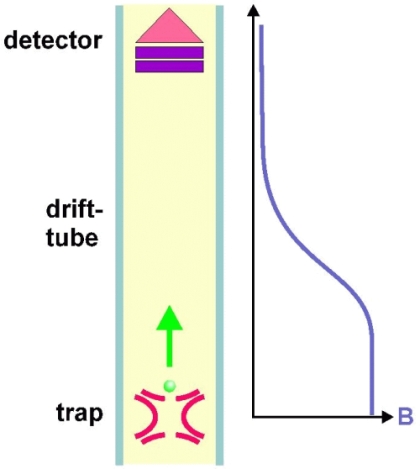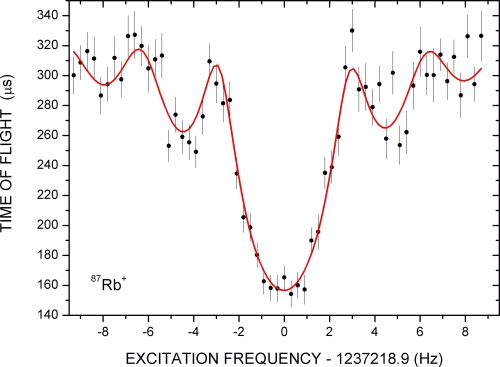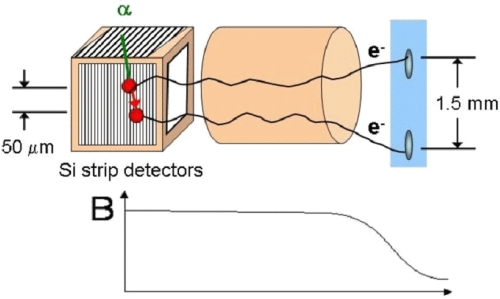Penning-Trap developments: experimental techniques
Experiments: Measurement Technique - Destructive time-of-flight detection method:
The ion motions can be manipulated individually either by resonant dipolar radiofrequency (RF) excitations or at their different sum frequencies applied as quadrupolar RF fields. The sideband frequency, ω+ + ω-, which ideally corresponds to the free cyclotron frequency wc is measured. It is proportional to the charge-to-mass ratio, wc = qB/m. Hence, a precise comparison of cyclotron frequencies yields a precise mass determination, given that the reference mass is accurately known. The resonance at wc is indirectly determined via the destructive time-of-flight detection method [1]: Here, ions are excited in the trap prior to their ejection towards a detector and the resulting time-of-flight is measured.

While being ejected, ions drift along the gradient of the magnetic field towards a detector.
A resonant excitation at ω+ + ω-leads to a coupling between both eigenmotions and the gain in radial energy is maximal. While drifting along the gradient of the magnetic field to the detector, ions are accelerated according to the amount of their radial energy. This results in a characteristic cyclotron resonance curve, and the flight time is minimized if the resonance is met. This method is used worldwide by Penning trap mass spectrometers for short-lived ion species.

Characteristic cyclotron resonance curve of 87Rb ions.
Development of in-trap decay spectroscopy techniques
The features of ion manipulation and purification steps within Penning traps are favorable in nuclear decay-spectroscopy experiments on short-lived ions, which are ideally prepared as isobarically or even isomerically pure samples. A novel in-trap spectroscopy setup is developed at MLLTRAP [2] to be implemented in the future MATS facility [3] at the low-energy branch of FAIR/GSI. Here, the main trapping electrodes will be replaced by position-sensitive Si-strip detectors and emitted electrons are efficiently guided towards detectors by the strong field of the trap magnet. Possible physics experiments are conversion-electron spectroscopy and in-trap alpha-decay experiments of heavy actinides.

Principle of a recoil-distance type lifetime measurement method with an in-trap setup based on a coincidence measurement between alpha decay and position-sensitive detection of electrons.
One of the planned types of experiments are lifetime measurements of the first excited 2+ states resulting from a heavy even-even nucleus alpha decay. Typically, the alpha decay of a heavy even-even nucleus leads partly to daughter nuclides in the first excited 2+ states. The populating alpha decay initiates the emission of low-energy shake-off electrons that allow determining the original location of the decay. After a lifetime of typically few 100 ps the 2+ state decays via L conversion, again emitting shake-off electrons. Since the recoil nucleus travels a distance of typically ≈ 50 μm during the lifetime of the 2+ state, there is a distinct distance between the origin of both electron components. This distance can be magnified by an adiabatic expansion of electron trajectories along the magnetic field gradient towards a position-sensitive electron detector. Alternatively, in-trap conversion electron spectroscopy can be performed by efficiently guiding the emitted electrons along the magnetic field lines to a high-resolution electron detector.
[1] G. Gräff, H. Kalinowsky, and J. Traut, A Direct Determination of the Proton Electron Mass Ratio, Z. Phys. A 297, 35 (1980).
[2] C. Weber, P. Müller, P.G. Thirolf, Developments in Penning trap (mass) spectrometry at MLLTRAP:
Towards in-trap decay spectroscopy, International Journal of Mass Spectrometry 349–350, 270–276 (2013).
[3] D. Rodriguez et al., MATS and LaSpec: High-precision experiments using ion traps and lasers at FAIR, Eur. Phys. J. ST 183, 1 (2010).

